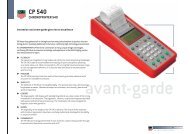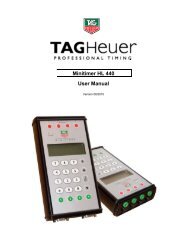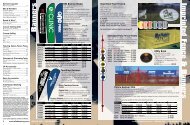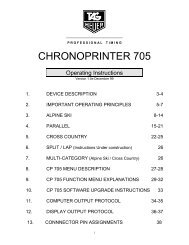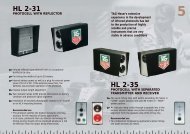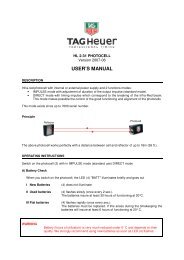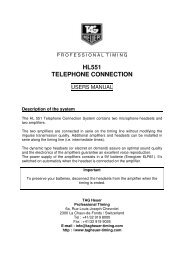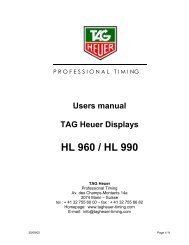TAG Heuer HL610-1 Transmitter Only Manual - Reliable Racing
TAG Heuer HL610-1 Transmitter Only Manual - Reliable Racing
TAG Heuer HL610-1 Transmitter Only Manual - Reliable Racing
You also want an ePaper? Increase the reach of your titles
YUMPU automatically turns print PDFs into web optimized ePapers that Google loves.
IMPULSES RADIO TRANSMISSION SYSTEM<br />
HL 610<br />
OPERATING INSTRUCTIONS<br />
1. DESCRIPTION OF THE FOUNCTIONS .....................................................Page 2<br />
2. DESCRIPTION OF THE SYSTEM ..............................................................Page 4<br />
3. TEST AND FUNCTIONING PRINCIPLE OF THE SYSTEM.......................Page 5<br />
4. INSTALLATION OF THE TRANSMITTERS AND THE RECEIVER...........Page 6<br />
5. BATTERY AND ACCUMULATOR CONTROL...........................................Page 7<br />
6. REPLACEMENT OF THE BATTERY– <strong>HL610</strong> TRANSMITTER.................Page 8<br />
7. TECHNICAL SPECIFICATIONS.................................................................Page 8<br />
TH Timing – Juin 2007 1
1. DESCRIPTION OF THE FOUNCTIONS<br />
TRANSMITTER<br />
9 8<br />
4<br />
7<br />
5<br />
6<br />
1<br />
RECEIVER<br />
9 10<br />
4<br />
5<br />
3<br />
2 2<br />
TH Timing – Juin 2007 2
1. DESCRIPTION OF THE FUNCTIONS (Following)<br />
1. INPUT Input for timing impulses (Start gate, photocell – working / closing contact).<br />
Respect the polarities.<br />
2. OUTPUTS Outputs of the timing impulses isolated by optocoupler (1 to 4 – working /<br />
closing contact). Respect the polarities.<br />
3. POWER To switch on of the receiver (press during 3 seconds on POWER). The red<br />
LED is on. To switch off the receiver, activate SET and press POWER.<br />
4. SET To program the TEAM (A, B, C, D) or CHANNEL (1, 2, 3, 4) and to switch off<br />
the receiver. Maintain SET pressed during the changes.<br />
5. TEAM To check the programmed TEAM. The green LED corresponding to the code A,<br />
B, C or D is on. To change the code, activate SET and press TEAM.<br />
6. CHANNEL To check the programmed CHANNEL. The green LED corresponding to the<br />
CHANNEL 1, 2, 3 or 4 is on. To change the CHANNEL, activate SET and press<br />
CHANNEL.<br />
7. TEST To test the impulses transmission.<br />
8. BATT To check the state of the battery.<br />
9. LEDS Control LED of the programmed TEAM or CHANNEL. Allows visualizing the<br />
transmitted impulses by the transmitter or received by the receiver.<br />
.<br />
10. LEDS LED to monitor the signal quality of the received impulses / or possible<br />
interferences created by other radio signals.<br />
TH Timing – Juin 2007 3
2. DESCRIPTION OF THE SYSTEM<br />
<br />
Low power impulses transmission system (10 Mw) which doesn’t need any license (free of<br />
use) in Europe (ISM Band – 433.56 MHz).<br />
<br />
Each receiver can receive impulses (simultaneously or not) from 4 transmitters identified by<br />
the function "CHANNEL" (1 to 4).<br />
<br />
Up to 4 teams can work (train) in the same area without disturbing each others thanks to the<br />
function "TEAM" which offers the possibility to code each system (A, B, C, D).<br />
It is also possible to use up to16 transmitters with 4 receivers.<br />
The transmitter is equipped with a lithium battery insuring autonomy of approximately 3<br />
years. There is no switch ON / OFF.<br />
<br />
The receiver is equipped with an internal accumulator insuring autonomy of at least 24 hours<br />
at 20 °C. 8 hours of charging are necessary to obtain the maximum capacity.<br />
<br />
When the receiver is switched on, it is possible that one or more green LED’s are on before<br />
that the transmitter(s) start to transmit. This system of detection allows visualizing the quality<br />
of the received signal, but also the possible interferences coming from other radio<br />
transmission systems. If it is not possible to stop these interferences by moving the receiver,<br />
the transmission of impulses cannot be guaranteed.<br />
THE INSTALLATION INCLUDES:<br />
<br />
<br />
<br />
<br />
<br />
<br />
<br />
1 Plastic case which can contains up to 4 transmitters<br />
1 to 4 transmitters<br />
1 Receiver<br />
2 to 5 antennas and 1 adapter right angle BNC<br />
1 Charger 100-240 VAC / 9VDC<br />
1 User manual<br />
1 Velcro strap per transmitter<br />
Remark:<br />
If the SET that you received contains an antenna longer than the others, it is intended for<br />
the receiver.<br />
TH Timing – Juin 2007 4
3. TEST AND FUNCTIONING PRINCIPLE OF THE SYSTEM<br />
<br />
Connect the antennas on the receiver and transmitters. The antennas must always be<br />
positioned vertically. Use the adapter right angle BNC if the receiver is placed horizontally.<br />
<br />
Switch ON the receiver by pushing approximately 3 seconds on POWER. The red LED is on<br />
(see chapter 6 ).<br />
<br />
Check the programmed "TEAM" (A, B, C or D) on the receiver and the transmitters. It must<br />
be identical for each system. To change it, activate SET and press TEAM.<br />
Check the programmed channel N° (CHANNEL) on each transmitter (1, 2, 3 or 4). This N°<br />
corresponds to the OUTPUT N° of the receiver. This / or these OUTPUTS are connected to<br />
the timing device. To modify the OUTPUT N°, activate SET and press CHANNEL.<br />
<br />
Press TEST on the transmitter (transmission test)<br />
- The green LED of the transmitter (1 to 4) corresponding to the selected channel N° is on<br />
and a “beep” signal confirms the sending of the impulse.<br />
- The green LED of the receiver corresponding to the channel N° of the transmitter (1 to 4)<br />
is on and a “beep” signal confirms the reception of the impulse which is provided on the<br />
corresponding output (1 to 4) to the timing device.<br />
- The 4 green LED’s on the receiver unit allows you to monitor the quality of the signals being<br />
received.<br />
1 led is on - > Very weak Signal<br />
2 led’s are on - > Weak Signal<br />
3 led’s are on - > Signal satisfactory<br />
4 led’s are on - > Good Signal<br />
(see chapter 2. “Description of the system HL 610”)<br />
<br />
At the end of the test or use of the system, do not forget to switch off the receiver!<br />
Activate SET and press POWER<br />
TH Timing – Juin 2007 5
4. INSTALLATION OF THE TRANSMITTERS AND THE RECEIVER<br />
The HL 610 must be used in an open environment. Difficult topography (Undulating country),<br />
obstacles or trees can significantly decrease the performances of the installation. It is in all the<br />
cases recommended to place the transmitters in the highest possible location for a maximum<br />
reliability.<br />
Installation methods (<strong>Transmitter</strong>s)<br />
Optimal Satisfactory Very good<br />
WARNING : the transmitters should always be installed VERTICALLY<br />
To fix the transmitters on wooden-post, skis or photocells, you can use Velcro, Straps, Serflex or<br />
quick fixation. Tag <strong>Heuer</strong> will be able to provide you a specific product during January 2004.<br />
The receiver can be fixed vertically or positioned horizontally using the right angle BNC adapter.<br />
WARNING !<br />
The transmitter must be protected from the rain<br />
WARNING !<br />
The antennas should not be hidden. They are mounted vertically with a direct view<br />
between transmitter and receiver.<br />
TH Timing – Juin 2007 6
5. BATTERY AND ACCUMULATOR CONTROL<br />
TRANSMITTER<br />
Press BATT to check the battery power condition.<br />
Good battery:<br />
2 « BEEPS » will be heard and 4 green LED’s are on.<br />
Rather good battery: 2 « BEEPS » will be heard and 3 green LED’s are on.<br />
Acceptable battery: 2 « BEEPS » will be heard and only 2 green LED’s are on.<br />
It is possible by low temperature (- 10°C or 14° F ) to find this situation. The power of the Battery<br />
decreases and can make believe that this one is out of use.<br />
Bad battery:<br />
3 « BEEPS » will be heard and only 1 green LED is on. You must replace the<br />
battery, a normal use is no more guaranteed.<br />
Discharged battery: 3 « BEEPS » will be heard and no green LED is on. The system is out of<br />
use.<br />
WARNING !<br />
If the battery of the transmitter is out of order or defective, we recommend to<br />
contact your local <strong>TAG</strong> <strong>Heuer</strong> Timing Agent. At the same time, you will have the<br />
opportunity to control the accumulators of the receiver.<br />
RECEIVER<br />
When the receiver is switched on, the control of the accumulators conditions is ensured by the red<br />
LED POWER.<br />
Accu charged:<br />
Accu slightly<br />
discharged:<br />
The red LED is on.<br />
The red LED flashes each second.<br />
Accu discharged: The red LED flashes very fast (more than 1 per second) The good<br />
functioning of the system is no more guaranteed.<br />
To recharge the receiver, use the original charger AC/DC provided by <strong>TAG</strong> <strong>Heuer</strong>. The use of<br />
another charger can seriously damage or destroy the device.<br />
- Switch off the receiver to recharge the accumulators (POWER OFF).<br />
- Connect the charger to a normal household ac current receptacle.<br />
- Connect the jack of the Charger to the receiver.<br />
- The red LED POWER flashes during the charging.<br />
- WARNING : always recharge the receiver at temperatures higher than 0°C<br />
WARNING ! The recharge time is automatically stopped after 8 hours (internal clock).<br />
This is the necessary space of time to recharge the device when LED POWER is<br />
flashing.<br />
Don’t charge the battery if not necessary (see autonomy) to guarantee a better<br />
long life of them.<br />
Remark:<br />
It is possible to use the charger during the timekeeping with the receiver switched on.<br />
However, no particular message will be given by the LED POWER.<br />
TH Timing – Juin 2007 7
6. REPLACEMENT OF THE BATTERY– <strong>HL610</strong> TRANSMITTER<br />
Battery: LITHIUM 3V (CR2430)<br />
Procedure:<br />
1. With the point of a knife or a "cutter", remove the two small black stoppers located on<br />
both sides of the green connection at the bottom of the transmitter.<br />
2. With a screw driver “torx n°9 “ unscrew both screws.<br />
3. Remove the cover gently. Caution is required with the connections.<br />
4. With a pair of plastic tweezers remove the battery.<br />
Warning to not short-circuit the battery with a metallic tool.<br />
If plastic tweezers are unavailable then insulate a pair of metal tweezers.<br />
5. Replace the battery in the same position taking notice of the polarity.<br />
6. Re-assemble and replace the cover gently.<br />
Do not over-tighten the screws.<br />
7. Replace the black stoppers in their location.<br />
7. TECHNICAL SPECIFICATIONS<br />
Type of emission:<br />
ISM Band – 433.5 6MHz<br />
Code: 4 differentiated Channels (A, B, C, D)<br />
Radiated Power Output: 10 mW<br />
Range:<br />
Superior to 2 km under optimal conditions, direct view<br />
Antenna: Multiflex 1/4<br />
Timing Impulse Inputs: Open Working contact. Respect the polarities (Black = Ground)<br />
Timing Outputs:<br />
4 opto-isolated independent output<br />
Precision:<br />
Fixed delay of 100ms +/- better than 1/10,000 th second.<br />
Signal Transmission Evidence: By audible tone (buzzer) and LED (1, 2, 3, 4)<br />
Signal Reception Evidence: By audible tone (buzzer) and LED (1, 2, 3, 4)<br />
Signal Reception Monitoring: By 4 LED’s. Control of the quality of the reception and of<br />
eventual disturbances.<br />
Battery Condition Monitoring: By red LED (POWER)<br />
On -> well charged<br />
Flashing -> to be recharged<br />
Power Supply:<br />
By internal battery (lithium) for the transmitter and by internal<br />
rechargeable accumulator for the receiver<br />
Charger:<br />
AC/DC Adapter<br />
100 – 240 VAC / 9VDC – 550 mA<br />
Polarity: positive at the center of the plug<br />
Autonomy:<br />
Approximately 3 years for the transmitter<br />
Approximately 24 Hours for the receiver at 20°C<br />
Operating Temperature Range: -20°C à + 60 °C<br />
Mounting:<br />
By Velcro or Serflex strap<br />
Dimensions & weight<br />
<strong>Transmitter</strong> : 100 x 57 x 32 mm / weight of 175 gr.<br />
Receiver : 100 x 82 x 32 mm / weight of 380 gr.<br />
Guaranty:<br />
One year starting from the purchase date<br />
The guaranty is null and void under the following conditions:<br />
- Accumulators or battery out of use<br />
- Bad maintenance and obvious damages<br />
- Input or Outputs damaged by bad connection<br />
- If the device was open without factory authorization<br />
TH Timing – Juin 2007 8



